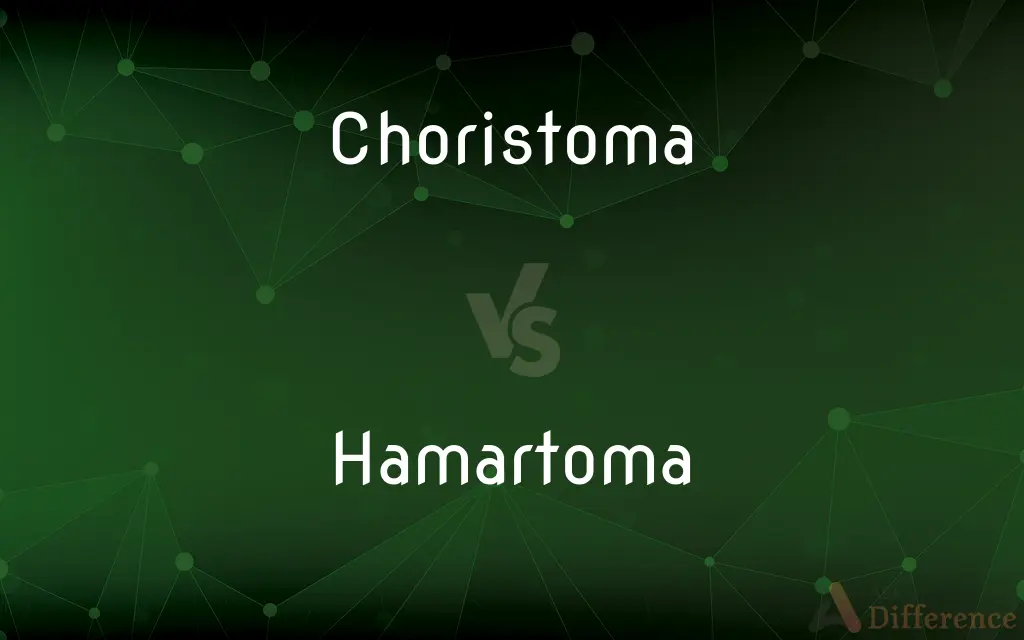Choristoma vs. Hamartoma — What's the Difference?
Edited by Tayyaba Rehman — By Maham Liaqat — Updated on April 21, 2024
Choristoma is an ectopic growth of normal tissue in abnormal locations, while hamartoma is a benign tumor-like growth composed of mature tissues normally found in the affected area.

Difference Between Choristoma and Hamartoma
Table of Contents
ADVERTISEMENT
Key Differences
Choristoma is characterized by the growth of normal tissue, but in an area where it does not belong. Whereas hamartoma involves an excessive, but disorganized, growth of tissues that normally occur in the region it appears.
Choristoma can occur in various parts of the body, such as the oral cavity, brain, or eye, often leading to functional disturbances due to its abnormal location. On the other hand, hamartoma is typically found in organs like the lungs, liver, or kidneys and usually grows at the same rate as the surrounding tissues, causing fewer symptoms unless it becomes large.
Choristoma is not considered a true neoplasm because it does not arise from cellular mutations but rather from developmental errors during embryogenesis. In contrast, hamartoma is often regarded as a benign neoplasm because it consists of an abnormal mixture of cells and tissues.
Choristoma is less common than hamartoma and can be more challenging to diagnose due to its rarity and unusual location. Conversely, hamartoma is more commonly recognized and often diagnosed incidentally during imaging studies for unrelated reasons.
Choristoma treatment depends on its location and the symptoms it causes, often requiring surgical removal if problematic. Meanwhile, hamartoma may not need treatment unless it impairs organ function or becomes symptomatic.
ADVERTISEMENT
Comparison Chart
Definition
Growth of normal tissue in an abnormal site
Benign growth of disorganized tissue in its site
Location in the body
Any, often ectopic
Typically in the organ where it originates
Developmental origin
Embryonic developmental errors
Overgrowth of mature cells and tissues
Common affected areas
Brain, eye, oral cavity
Lungs, liver, kidneys
Typical clinical approach
Surgical removal if symptomatic
Observation or surgical intervention if necessary
Compare with Definitions
Choristoma
A benign growth comprising histologically normal tissue in an ectopic location.
A choristoma in the middle ear presented as a mass obstructing hearing.
Hamartoma
Often presents in the lungs, liver, and kidneys.
His lung hamartoma was asymptomatic and required no treatment.
Choristoma
Often asymptomatic, detected incidentally during examinations for other conditions.
The choristoma was discovered during a routine dental X-ray.
Hamartoma
Treatment is not always necessary unless symptoms develop.
The decision was made to monitor the hamartoma rather than operate immediately.
Choristoma
Requires surgical intervention if it causes functional impairment.
The patient underwent surgery to remove a choristoma that compressed adjacent brain tissue.
Hamartoma
A benign, tumor-like nodule made up of an abnormal mixture of tissues.
A pulmonary hamartoma was spotted on the chest X-ray.
Choristoma
Not a true tumor but a developmental anomaly.
Pathology confirmed the mass as a choristoma, not a neoplastic growth.
Hamartoma
Frequently found during imaging studies for unrelated issues.
The abdominal CT revealed a small liver hamartoma.
Choristoma
Can appear in various organs, presenting diagnostic challenges.
A choristoma in the eyelid was initially misdiagnosed as a chalazion.
Hamartoma
Growth rate is consistent with that of the surrounding normal tissues.
The hamartoma in her kidney has not changed size over the last year.
Choristoma
Choristomas, a form of heterotopia, are masses of normal tissues found in abnormal locations. In contrast to a neoplasm or tumor, the growth of a choristoma is normally regulated.It is different from a hamartoma.
Hamartoma
A hamartoma is a mostly benign, local malformation of cells that resembles a neoplasm of local tissue but is usually due to an overgrowth of multiple aberrant cells, with a basis in a systemic genetic condition, rather than a growth descended from a single mutated cell (monoclonality), as would typically define a benign neoplasm/tumor. Despite this, many hamartomas are found to have clonal chromosomal aberrations that are acquired through somatic mutations, and on this basis the term hamartoma is sometimes considered synonymous with neoplasm.
Choristoma
A collection of normal cells in an abnormal location.
Adrenal choristoma
Hamartoma
A benign tumor composed of an abnormal mixture of normal tissue elements that develop and grow at the same rate as adjacent tissue, resulting from faulty development in an organ.
Hamartoma
(pathology) A benign mass of disorganized tissue.
Hamartoma
A focal growth that resembles a neoplasm but results from faulty development in an organ
Common Curiosities
How is a hamartoma diagnosed?
Hamartomas are usually diagnosed through imaging techniques such as X-rays, CT scans, or MRIs, often found incidentally.
Are choristomas cancerous?
No, choristomas are benign and not cancerous, but they can cause issues depending on their size and location.
What is the difference in treatment approaches for choristomas and hamartomas?
Choristomas often require surgical removal if symptomatic, while hamartomas may be monitored or removed if they cause functional impairment.
What causes a choristoma to develop?
Choristomas are caused by developmental errors during embryogenesis, leading to normal tissue growing in an abnormal location.
How common are choristomas and hamartomas?
Hamartomas are relatively common, particularly in organs like the lungs and liver. Choristomas are much rarer.
Can choristomas grow larger over time?
Typically, choristomas do not grow significantly over time as they consist of mature tissue.
What are the risks associated with leaving a hamartoma untreated?
Untreated hamartomas may continue to grow and potentially cause complications by compressing nearby tissues or organs.
Are there genetic factors involved in the development of hamartomas?
Yes, certain genetic syndromes like tuberous sclerosis are associated with the development of hamartomas.
Can children develop choristomas or hamartomas?
Yes, both choristomas and hamartomas can occur in children and are usually congenital.
Do choristomas and hamartomas show any symptoms?
Both may be asymptomatic, especially if small. Symptoms, if present, are usually due to pressure or obstruction caused by the size and location of the growth.
Can hamartomas occur in multiple organs at once?
Yes, especially in the context of genetic syndromes, hamartomas can appear in multiple organs simultaneously, affecting overall health and treatment strategies.
Can hamartomas turn into cancer?
While hamartomas are generally benign, some types in certain locations may have a small risk of malignant transformation.
Are there any preventive measures for choristomas or hamartomas?
There are no specific preventive measures for these conditions as they are largely congenital or due to genetic predispositions.
What are the potential complications of surgical removal of a choristoma?
Complications can include typical surgical risks like infection or bleeding, and specific risks related to the location of the choristoma, such as nerve damage.
What impact do hamartomas have on life expectancy?
Hamartomas typically do not affect life expectancy unless they cause significant complications or are part of a broader genetic disorder.
Share Your Discovery

Previous Comparison
Cladding vs. Lining
Next Comparison
Emollient vs. EmulsionAuthor Spotlight
Written by
Maham LiaqatEdited by
Tayyaba RehmanTayyaba Rehman is a distinguished writer, currently serving as a primary contributor to askdifference.com. As a researcher in semantics and etymology, Tayyaba's passion for the complexity of languages and their distinctions has found a perfect home on the platform. Tayyaba delves into the intricacies of language, distinguishing between commonly confused words and phrases, thereby providing clarity for readers worldwide.
















































